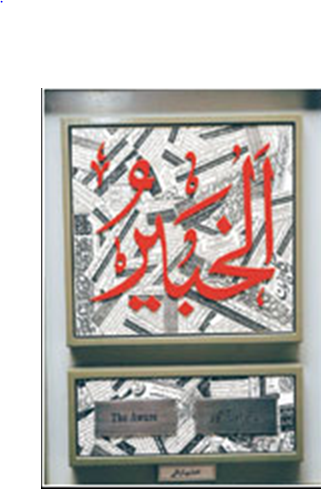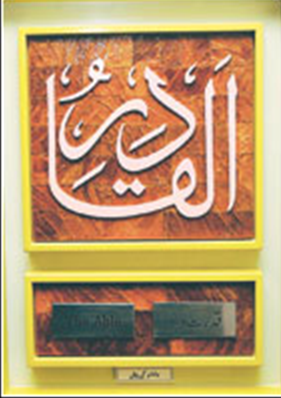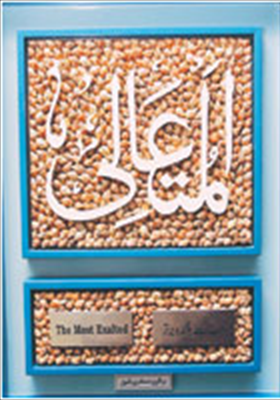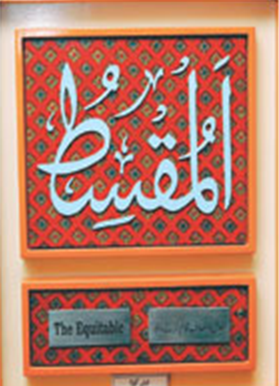Calligraphy: Pakistan
(→Calligraphy) |
|||
| Line 33: | Line 33: | ||
Maroof has developed these ninety-nine different works of art in ninety-nine different colour schemes, materials and combinations of materials, which makes his display rather unique and unparalleled. It took him over two years to complete this project. Not only has Maroof employed traditional art media, such as marble, metal, plastic, cloth, plaster of Paris, fibre glass et cetera, but he has also made use of media which are not traditionally used in art. Some of these are rosary beads, peacock feathers, herbs, coal, chaliya etc. They have been employed in such a manner that they aptly serve the artist’s expressive purpose. For example, Ahmed makes use of cuttings and clippings from newspapers in his frame which expresses God’s attribute of being ‘aware and all-knowing’ (al-Khabeer), for no other reason but that it perfectly highlights this particular attribute of the Almighty. In another frame focusing on God’s attribute of being ‘the hidden one’ (al-Batin), he makes use of an X-ray film to reinforce and concretise his expression. In yet another frame, he employs pieces of glass bangles which not only beautify the corresponding work but also serve to facilitate the depiction. | Maroof has developed these ninety-nine different works of art in ninety-nine different colour schemes, materials and combinations of materials, which makes his display rather unique and unparalleled. It took him over two years to complete this project. Not only has Maroof employed traditional art media, such as marble, metal, plastic, cloth, plaster of Paris, fibre glass et cetera, but he has also made use of media which are not traditionally used in art. Some of these are rosary beads, peacock feathers, herbs, coal, chaliya etc. They have been employed in such a manner that they aptly serve the artist’s expressive purpose. For example, Ahmed makes use of cuttings and clippings from newspapers in his frame which expresses God’s attribute of being ‘aware and all-knowing’ (al-Khabeer), for no other reason but that it perfectly highlights this particular attribute of the Almighty. In another frame focusing on God’s attribute of being ‘the hidden one’ (al-Batin), he makes use of an X-ray film to reinforce and concretise his expression. In yet another frame, he employs pieces of glass bangles which not only beautify the corresponding work but also serve to facilitate the depiction. | ||
| + | |||
| + | [[File: Calligraphy4.PNG| Calligraphy |frame|left|500px]] | ||
Revision as of 03:39, 1 November 2013
This is a collection of articles archived for the excellence of their content. Readers will be able to edit existing articles and post new articles directly |
Calligraphy
Inspired calligraphy
By Qurat ul ain Siddiqui
Calligraphy of the attributive names of Allah is quite popular amongst many local and international artists. However, the exhibition of upcoming artist, designer and sculptor, Maroof Ahmed recently held at the Arts Council in Karachi showed all the 99 names calligraphed in a rather unprecedented manner.
Maroof has developed these ninety-nine different works of art in ninety-nine different colour schemes, materials and combinations of materials, which makes his display rather unique and unparalleled. It took him over two years to complete this project. Not only has Maroof employed traditional art media, such as marble, metal, plastic, cloth, plaster of Paris, fibre glass et cetera, but he has also made use of media which are not traditionally used in art. Some of these are rosary beads, peacock feathers, herbs, coal, chaliya etc. They have been employed in such a manner that they aptly serve the artist’s expressive purpose. For example, Ahmed makes use of cuttings and clippings from newspapers in his frame which expresses God’s attribute of being ‘aware and all-knowing’ (al-Khabeer), for no other reason but that it perfectly highlights this particular attribute of the Almighty. In another frame focusing on God’s attribute of being ‘the hidden one’ (al-Batin), he makes use of an X-ray film to reinforce and concretise his expression. In yet another frame, he employs pieces of glass bangles which not only beautify the corresponding work but also serve to facilitate the depiction.
It is almost surprising to see an artist as young as Maroof produce exceptional work on an individual scale by employing different media in varying ways as well as the painstaking efforts he has made for the preservation of some of the materials used which usually lose their original outlook and texture over time.
The inspiration for Maroof Ahmed, to state the obvious, comes from religion and God, and clearly reserves an important place for the young artist in the area of sub-continental Islamic Art. Maroof’s work shows a lot of talent and promise and he is sure to make a name for himself in the years to come.



